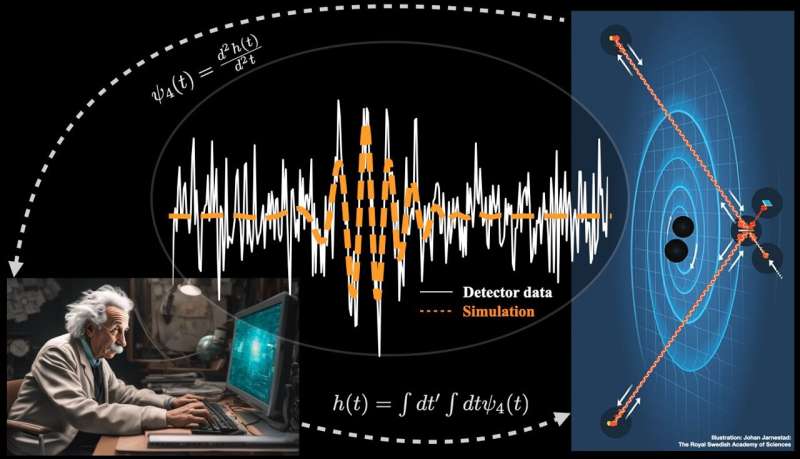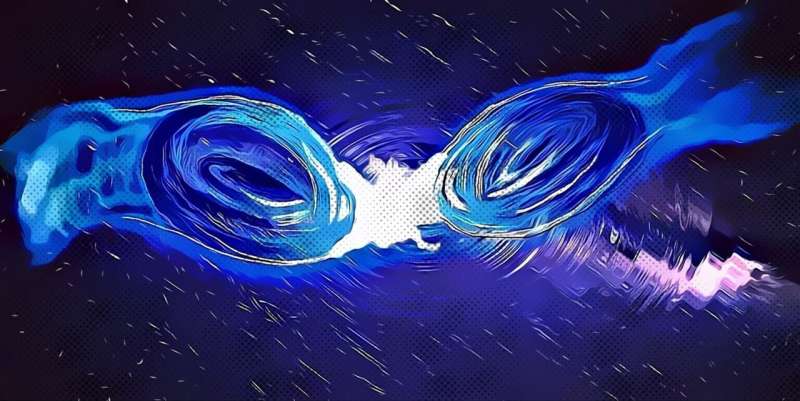This article has been reviewed according to Science X's editorial process and policies. Editors have highlighted the following attributes while ensuring the content's credibility:
fact-checked
peer-reviewed publication
trusted source
proofread
Scientists flip around gravitational-wave data analysis: Have LIGO and Virgo detected a merger of dark-matter stars?

Gravitational waves are ripples in the fabric of spacetime that travel at the speed of light. These are produced in some of the most violent events in the universe, such as black-hole mergers, supernovae, or the Big Bang itself. Since their first detection in 2015, and after three observing runs, the Advanced LIGO and Virgo detectors have detected around 100 such waves.
Thanks to these observations, we are starting to unveil the black-hole population of our universe, study gravity in its most extreme regime and even determine the formation of elements like gold or platinum during the merger of neutron stars.
The LIGO and Virgo detectors are nothing but the most precise rulers ever built by humankind, able to measure the subtle squeezing and stretching of spacetime produced by gravitational waves.
The detection of the waves and determination of their sources, relies on the comparison of the detector data to theoretical models, or "templates," for the waves emitted by each type of source. This is in essence the way the famous Shazam app tells us the details (name, author, year.) of the music being played in a bar.
While there are several ways to compute gravitational-wave templates, the most accurate one (and sometimes the only one) is through extremely accurate numerical simulations performed on some of the most powerful supercomputers in the world. There is, however, a caveat: most numerical simulations do not output the quantity that the detectors read, known as strain, but its second-time derivative, known as the Newman-Penrose scalar.
This makes scientists need to perform two-time integrals on the result of their simulations. Dr. Isaac Wong, co-lead of the study from the Chinese University of Hong Kong, explains, "While taking integrals may sound simple, this operation is subject to well-known errors that we can only handle for rather simple sources like the merger of black holes in circular orbits that LIGO and Virgo have been detecting so far. Moreover, doing this is not straightforward, requiring quite some hand tuning that involves human choices."
In recent work published in the journal Physical Review X, a team led by Dr. Juan Calderón Bustillo "La Caixa Junior Leader" and "Marie Curie Fellow" at the Galician Institute of High Energy Physics (Spain) and Dr. Isaac Wong, from the Chinese University of Hong Kong, have proposed to flip around the way gravitational-wave analyses have been performed since its birth.
Rather than taking integrals on their simulations, the authors propose taking derivatives on the detector data, while leaving their simulations untouched.

Dr. Calderón-Bustillo explains, "While this may look like quite a trivial tweak, it comes with great advantages. First, this greatly simplifies the process of obtaining templates that can be compared to LIGO-Virgo data. Most importantly, we can now do this safely for any source that supercomputers can simulate."
In fact, the team has long been interested in studying the possibility that some of the current signals may be due to something way more exotic and mysterious, known as boson stars.
Dr. Sanchis-Gual, co-author of the study from the University of Valencia says, "Boson stars behave very much like black holes, but they are fundamentally different, as they lack the two most distinctive (and somewhat problematic) aspects of black holes: their no-return surface known as event horizon, and the singularity in the interior, where laws of physics break down."
While the team knew how to simulate these sources in supercomputers, "we were having real trouble understanding how to transform the output of our simulations into something we could compare with the detector data, due to well-known issues. The idea of taking derivatives from the data, made things extremely simple," says Prof. Alejandro Torres, also from the University of Valencia.
As a first application of their new technique, in a separate work published in Physical Review D, the team compared some gravitational-wave events observed by LIGO and Virgo to a large catalog of simulations for boson-star mergers.
"If existing, boson star mergers exist, these could account for at least part of what we know as dark matter," says Prof. Carlos Herdeiro, from the University of Aveiro.
In fact, the team found that one of the most mysterious events observed to date, known as GW190521, is indeed consistent with such simulations. This reinforces a similar result obtained by the team in 2020, obtained using a significantly smaller catalog.
Samson Leong, Ph.D student from the Chinese University of Hong Kong, involved in both studies says, "It's very exciting to see that GW190521 is consistent with a boson-star merger. This does not underscore the potential role of these exotic objects in the future of gravitational wave astronomy."
Prof. Tjonnie Li, from K.U. Leuven adds, "This result also demonstrates the power of our new approach. By simply taking derivatives, we've opened a broader window for exploring and understanding the cosmos through gravitational waves."
More information: Juan Calderón Bustillo et al, Gravitational-Wave Parameter Inference with the Newman-Penrose Scalar, Physical Review X (2023). DOI: 10.1103/PhysRevX.13.041048
Juan Calderón Bustillo et al, Searching for vector boson-star mergers within LIGO-Virgo intermediate-mass black-hole merger candidates, Physical Review D (2023). DOI: 10.1103/PhysRevD.108.123020
Journal information: Physical Review D , Physical Review X
Provided by Galician Institute of High Energy Physics




















